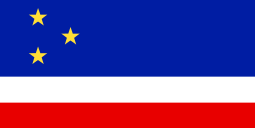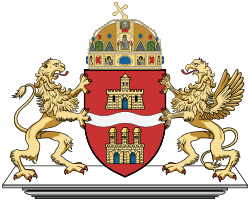Erzsébetváros
| Erzsébetváros Elizabeth Town | ||
|---|---|---|
| District of Budapest | ||
| District VII | ||
| ||
 Location of District V, shown in blue, in Budapest | ||
| Country | Hungary | |
| City | Budapest | |
| District | District VII | |
| Government | ||
| • Mayor | Vattamány Zsolt | |
| Area | ||
| • Total | 2.09 km2 (0.81 sq mi) | |
| Population | ||
| • Total | 62,034 | |
| • Density | 29,681.3/km2 (76,874/sq mi) | |
| Time zone | CET (UTC+1) | |
| • Summer (DST) | CEST (UTC+2) | |
| Website |
www | |
Erzsébetváros (German: Elisabethstadt or English: Elizabethtown) is the 7th district of Budapest, situated on the Pest side of the Danube. The inner half of the district was the historic Jewish quarter of Pest. The Dohány Street Synagogue, the largest functioning synagogue in Europe, is located in this district. Currently it is the most densely populated district of Budapest with 29,681.3 person per km2. In 1910 Erzsébetváros had 152,454 inhabitants. During the socialist era Erzsébetváros's population decreased rapidly, because young people and families moved to the newer "panelized" boom districts (Újpest, Újbuda, Óbuda, Kispest etc.). Gentrification and recovery started in the middle of the 2000s.
Name
Erzsébetváros was named after Queen Elisabeth, the popular wife of King Franz Joseph I on 17 January 1882.
Until the unification of Budapest in 1873 this area was part of Terézváros. Between 1873 and 1882 it was named District VII without name.
Politics
The current mayor of Budapest, VII. district is Zsolt Vattamány (Fidesz-KDNP).
The local District Assembly has 17 members divided into this political parties and alliances:[1]
| Party | Seats | 2014 Council | ||||||||
|---|---|---|---|---|---|---|---|---|---|---|
| Fidesz-KDNP | 8 | |||||||||
| Unity (DK-MSZP-Együtt-Füge-PM-EEE) | 7 | |||||||||
| Politics Can Be Different (LMP) | 1 | |||||||||
| Movement for a Better Hungary (Jobbik) | 1 | |||||||||
Twin towns
Erzsébetváros is twinned with:
-
 Sveti Vlas, Bulgaria
Sveti Vlas, Bulgaria -
 Požega, Croatia
Požega, Croatia -
 Nevers, France
Nevers, France -
 Stavroupoli, Thessaloniki, Greece
Stavroupoli, Thessaloniki, Greece -
 Siedlce, Poland
Siedlce, Poland -
 Stari Grad, Belgrade, Serbia
Stari Grad, Belgrade, Serbia -
 Karlovac, Croatia
Karlovac, Croatia -
 Safed, Israel
Safed, Israel -

 Comrat, Moldova (Gagauzia)
Comrat, Moldova (Gagauzia)
See also
Gallery
 Madách square
Madách square Blaha Lujza square
Blaha Lujza square the Synagogue
the Synagogue Square of Roses
Square of Roses
References
External links
Coordinates: 47°30′2″N 19°4′7.41″E / 47.50056°N 19.0687250°E
| Wikimedia Commons has media related to Erzsébetváros. |


